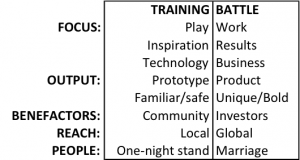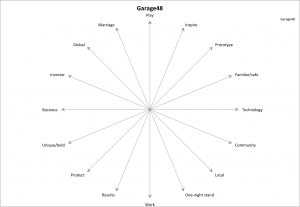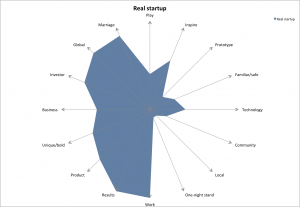The most recent Garage48 weekend event in Tallinn sparked some healthy discussion around the perceived and actually delivered value of this format towards the commonly accepted goal of creating more young, brave and hungry technology businesses in the country. The devoted fans of the time-constraint, playful and cutely random 48-hour hackathon were publicly questioned if their lack of attention to the big bad real world (business cases, marketing channels and Terms of Service legalese) were not accidentally misleading the youth to think that creating a real company is a joyride, lacking the need of solving the really hard problems.
Following the discussion (including further reading pointers in the end of this post) it felt like a bit more universal of a worry than just this particular event or our particular country. To share these concerns — and furthermore — seek further input from the international scene of startup support programs (and reacting to a random Facebook comment requesting the same) I decided to turn this conversation to English. And as it felt very little value add over Google Translate to start replicating the brightest arguments I decided to do something different.
Let’s try to visualize this conflict.
Visualizing Startup Events VS Startups Themselves
First, I read the the blog posts linked below and comment threads again and took some notes on recurring themes and keywords used.
Based on those I created a subjective set of evaluation scales to judge the Garage48 events’ goals, benefits and strengths against as well as to compare those to the needs of building an actual business. Some of chosen pairs can be grouped (like the focus of event, organization or team and their expected output – and while writing this, I notice that I forgot at least one pair of time constraints out of the list…) and others I kept singular for simplicity. Note that these are not necessarily positive-negative pairs so for illustration purposes I derived the overall notion of “training for the battlefield” from the mission of most startup incubation events.
This is the result:
As a next step I mapped these pairs on a radar graph, ending up with this template (click on any image to enlarge):
To populate the graph I combined the learnings from reading notes with some highly scientific gut feel from my personal experience from both attending Garage48 as well as building a few companies and rated each of the evaluation criteria on the scale of 0..10 (meaning: none..a lot), in most cases keeping the sum of each pair 10.
This is what a typical team participating in a Garage48 weekend event tends to deal with:
Whereas, as raised in passionate counter-commentary reality of a new tech business bootup process looks more like this:
So, the visualization of the gap between the worries of a weekend startup event versus an actual startup is quite radical indeed:
How to Close The Gap?
I am still a firm believer that crazy-fast hackathon events and Garage48 among them have a huge role to play still in their part of the circle: inspiring, boosting and motivating recruits before they enter the real battlefield and have to smell the gunpowder. Because the untrained get usually killed first. I will not dwell deeper on this argument but suggest you read a Quora thread on what Garage48 is doing really well.
At the same time, the Garage48 “training” doesn’t cover everything a budding company will need. And I do agree with Toivo that it could be fatally dangerous for Garage48 to “go against their DNA” and try to expand into a full circle on this graph: for example, including some active financial forecasting classes or setting business model viability gates to their grass-roots ideation would probably get us nowhere in the end.
Garage48 can do a little, bring in a mentor here and clarify some judging criteria there, but there is clear opportunity for other groups, programs and events to come in here. And we know that many of those actually already exist.
So my humble suggestion is that what if we use this same template to map the focus areas and strengths of those programs on the same (or similar) scales to make it easier for an eager, but unexperienced entrepreneur to set their target straight and spend their time where they feel their own personal gaps burning the most.
As an example, this is how a totally artificial and hypothetical business school could look like (further highlighting the unique strenghts of Garage48 BTW):
I am releasing the original quick-hack excel template for above graphs here if you want to play around:
- Garage48 vs real startups.xlsx – the original file
- UPDATE: 19/03/11: Garage48-vs-real-startups – v0.2 – added Tehnopol pre-incubation and incubation programs (see below)
It’s Creative Commons, go crazy, enhance the scales, add lines and play with anything else as much as you want. Would be great if you linked back here / linked to yourself from the comments if you publish any further output though.
If evolved a bit, maybe this could be a birth of a Startup Support Program Fingerprint ™?
UPDATE, 19/03/11: Martin Gorosko was kind enough to submit his take on what Tallinn Technology Park Tehnopol is attempting to do with their two programs: pre-incubation (for about 20 of every 200 incoming ideas) and incubation (where 3-4 projects enter from pre-incubation pool). As you can see, their initial approach to incubees (is that a word?) is a bit more cautious and less intense than Garage48, shifting more towards the “running a real business” side as the ideas mature:
I would love (one can dream, right?) to see how the following programs position themselves:
- Incubation programs at Tartu Science Park
- Ajujaht
- SeedBooster of Estonian Development Fund
- ASI Incubator
- Aalto Venture Garage
- StartupWeekend
- StartupBus
- Seedcamp
- Y! Combinator 😛
- (… please submit more to extend the list…)
And maybe I am so way off with this model that it is not worth your time. In which case I’d love to hear the honest critique or improvement suggestions to the model.
Thank you.
Last but not least, these are the orginal posts along with their very good comment threads that sparked this post. You have to be either an Estonian speaker or fond of Google Translate, though.






